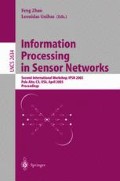Abstract
In this paper, we explore a novel avenue of saving power in sensor networks based on predictable mobility of the observer (or data sink). Predictable mobility is a good model for public transportation vehicles (buses, shuttles and trains), which can act as mobile observers in wide area sensor networks. To understand the gains due to predictable mobility, we model the data collection process as a queuing system, where random arrivals model randomness in the spatial distribution of sensors. Using the queuing model, we analyze the success in data collection, and quantify the power consumption of the network. Even though the modeling is performed for a network which uses only single hop communication, we show that the power savings over a static sensor network are significant. Finally, we present a simple observer-driven communication protocol, which follows naturally from the problem formulation and can be used to achieve the predicted power savings.
Access this chapter
Tax calculation will be finalised at checkout
Purchases are for personal use only
Preview
Unable to display preview. Download preview PDF.
References
R. Min and A. Chandrakasan, Energy-efficient communication for ad-hoc wireless sensor networks. In: Conference Record of the Thirty-Fifth Asilomar Conference on Signals, Systems and Computers. Volume 1. (2001) 139–143
G. J. Pottie, Wireless sensor networks. In: Information Theory Workshop (1998) 139–140
A. Salhieh, J. Weinmann, M. Kochha, and L. Schwiebert, Power efficient topologies for wireless sensor networks. In: International Conference on Parallel Processing. (2001) 156–163
R. Min, M. Bhardwaj, S.-H. Cho, A. Sinha, E. Shih, A. Wang, and A. Chandrakasan, An architecture for a power-aware distributed microsensor node. In: IEEE Workshop on Signal Processing Systems. (2000) 581–590
D. Estrin, Wireless sensor networks: Application driver for low power distributed systems. In: International Symposium on Low Power Electronics and Design. (2001) 194
J. M. Rabaey, J. Ammer, T. Karalar, S. Li, B. Otis, M. Sheets, and T. Tuan, Picoradios for wireless sensor networks: the next challenge in ultra-low power design. In: Digest of Technical Papers. ISSCC. IEEE International. Volume 2. (2001) 156–445
C.-H. Liu and H. Asada, A source coding and modulation method for power saving and interference reduction in ds-cdma sensor network systems. In Proceedings of the American Control Conference. Volume 4 (2002) 3003–3008
G. Pei and C. Chien, Low power tdma in large wireless sensor networks. In Military Communications Conference. Volume 1 (2001) 347–351
C. Chien, I. Elgorriaga, and C. McConaghy, Low-power direct-sequence spread-spectrum modem architecture for distributed wireless sensor networks. In: International Symposium on Low Power Electronics and Design. (2001) 251–254
M. Grossglauser and D. Tse, Mobility increases the capacity of ad hoc wireless networks. In: INFOCOM. Proceedings. IEEE. Volume 3 (2001) 1360–1369
K. Sohrabi, J. Gao, V. Ailawadhi, and G. J. Pottie, Protocols for self-organization of a wireless sensor network. IEEE Personal Communications 7 (2000) 16–27
Author information
Authors and Affiliations
Editor information
Editors and Affiliations
Rights and permissions
Copyright information
© 2003 Springer-Verlag Berlin Heidelberg
About this paper
Cite this paper
Chakrabarti, A., Sabharwal, A., Aazhang, B. (2003). Using Predictable Observer Mobility for Power Efficient Design of Sensor Networks. In: Zhao, F., Guibas, L. (eds) Information Processing in Sensor Networks. IPSN 2003. Lecture Notes in Computer Science, vol 2634. Springer, Berlin, Heidelberg. https://doi.org/10.1007/3-540-36978-3_9
Download citation
DOI: https://doi.org/10.1007/3-540-36978-3_9
Published:
Publisher Name: Springer, Berlin, Heidelberg
Print ISBN: 978-3-540-02111-7
Online ISBN: 978-3-540-36978-3
eBook Packages: Springer Book Archive

